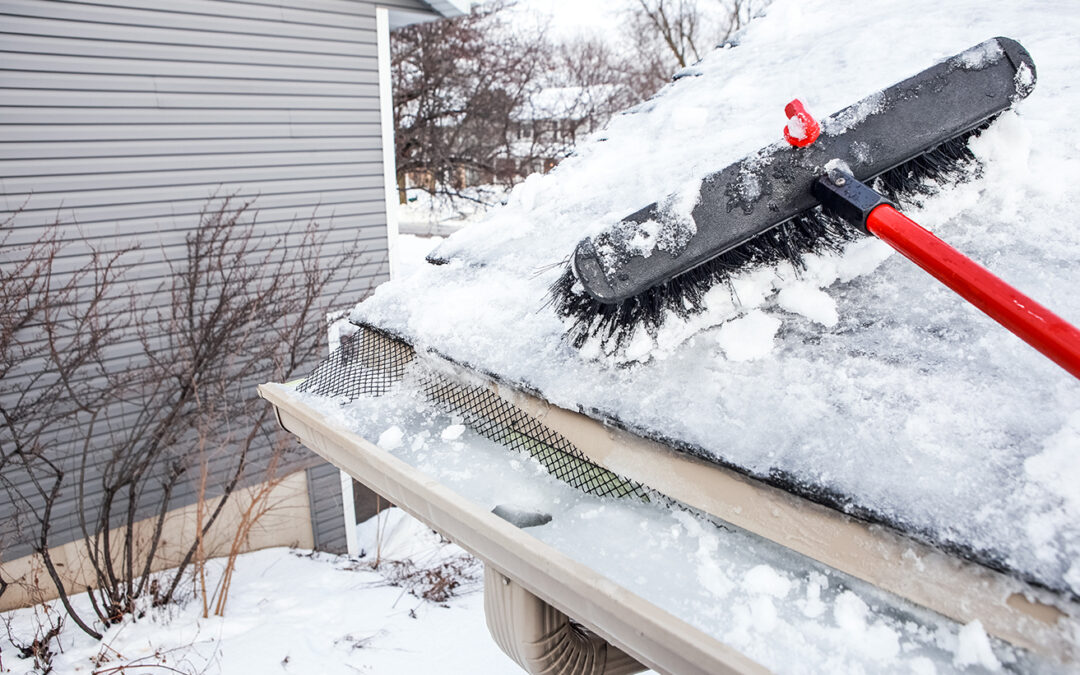Winter weather is hard on your home. While snow-covered roofs make for a picturesque greeting card scene, accumulation, melting, and refreezing can put significant stress on your roof. The last thing you want this winter is for leaks forming —or worse!— due to damage caused by snow and ice.
The hazardous winter conditions that affect your home can also put your safety at risk when attempting to address the issue. While it’s important to remove excess snow to prevent ice dams and other damage, icy conditions make getting up on a ladder or the roof itself a very risky endeavor. Make note of these safety tips to protect both your roof and your wellbeing this winter.
How Do I Know if I Need to Remove Snow from My Roof?
While some sources may tell you that you need to remove all snow from your roof as soon as it sticks, this is not the case. The fewer roof-related activities you attempt in the winter, the less likely you are to have an accident. Limit removal of snow to when it is absolutely necessary.
If you don’t know your roof’s weight-bearing capability, you’ll want to find out as soon as possible. Most recent constructions are rated for loads up to 40 pounds, though older buildings may not be up to these standards. When four feet of dry snow (or two feet of wet snow) is piled up on your roof, that is the time to act. Waiting any longer will risk structural damage or leaks into your home.
The pitch of your roof can also determine the necessity of snow removal. A steeper slope will shed snow much more easily than a gentler slope by itself. Flat roofs will likely require manual removal every time.
Be sure to take your local weather forecast into account as well. If your roof is already approaching that 2-4 foot limit, don’t wait until after another winter storm arrives before cleaning off the roof. The additional accumulation could very well be the straw that breaks the camel’s back.
Safety Tip #1: Stay on the Ground
All of the snow and ice and slippery slush that’s on the ground is also on your roof and ladder, making these surfaces very unstable and dangerous to climb or walk on. When you’re on the ground, the potential fall is a much lower risk for injury than if you’re on a ladder or the roof itself. Usually, there’s no need to climb onto the roof with the right tools that can be used from the ground (see the next tip for more info on that). Don’t take unnecessary risks with your safety in the name of perfection!
Safety Tip #2: Invest in a Roof Rake and Noncorrosive De-Icer
Using the wrong tools can cause serious damage to your roof. Any sharp metal or corrosive materials can damage the shingles, exposing your home to the elements. Avoid metal shovels, ice picks, rock salt de-icer, or any similar equipment. Instead, calcium chloride is an excellent noncorrosive de-icing option. Using a long-handled snow rake can also make it easier to reach the snow safely from the ground. These rakes should be made from plastic and pose no threat to your roof.
Safety Tip #3: Watch Out for Falling Snow and Ice
Pay close attention to what position you’re standing in when removing snow from your roof. Will you be pulling snow off right onto yourself? Are you standing underneath large icicles that could dislodge and fall on you? Don’t underestimate the potential injury that can come from a snowdrift falling from the roof and onto your head; it can be hard to tell if it’s just powder, or if the snow has melted and re-froze into a chunk of heavy ice.
Safety Tip #4: You Don’t Need to Remove Everything
Despite what some sources may tell you, it’s actually safer if you leave an inch or two of snow stuck to your roof rather than trying to remove every last bit. Excessive scraping, even with the right tools, can cause structural damage to your roof. Work in small batches to avoid piling up too much snow in one area, leading to a risk of collapse, and don’t sweat it if there’s stubborn small patches that aren’t perfectly clear. The main focus is to remove the bulk of the weight to remove the risk of damage to the roof, not to see every last shingle.

